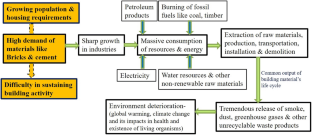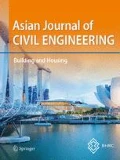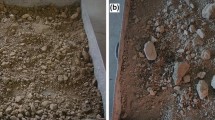Abstract
Today with rapidly increasing population and their housing demands, the whole world has been victimized by critical consequences of global warming and climate change. From simple to complex construction, materials being used not only consume massive energy and resources during their life cycle but also deteriorate the environment releasing an enormous amount of dust, solid waste, and greenhouse gases. With an intention to provide immediate solution in the form of sustainable alternative materials, rammed earth is chosen in this study where, natural sub-soil is used as primary constituent, i.e. clay (15–25%), sand (50–60%), gravel (15–20%) with/without small percentage of stabilizer like cement (3–5%), and minimum water (8–12%), and finally tamping the mix in required formwork using simple methods/tools, have clearly justified this construction as low consumer of resources and energy compared to other conventional building materials like brick and cement. This paper outlines environmental impacts of building construction and justifies suitability of rammed earth as an ideal sustainable housing both in terms of environmental and structural stability, based on results obtained from lab tests (compressive strength: 1.5–6.5 MPa, water resistivity, optimum water content) of 100 mm stabilized and un-stabilized cube samples (with variation in moisture content, soil and stabilizer types), site investigation for around 6 years, constructing and demonstrating two small-scaled stabilized and un-stabilized rammed earth houses, discussion with local people, builders and masons. Comparatively, cement-stabilized (5% cement) samples had better overall results than un-stabilized and dung-stabilized samples. In addition, cost comparison showed that 360-mm-thick rammed earth wall was 10–15% cheaper than 230-mm-thick brick wall. Similarly, further verifying and comparing the obtained findings with previous-detailed studies is one of the highlighting parts of this paper.















Similar content being viewed by others
References
Adam, E., & Agib, A. (2001). Compressed stabilised earth block manufacture in Sudan. France: Printed by Graphoprint for UNESCO.
Arezoumandi, M., Volz, J. S., Ortega, C. A., & Myers, J. J. (2013). Effect of total cementitious content on shear strength of high-volume fly ash concrete beams. Materials and Design,46, 301–309.
Australia Standard. (2002). Australian earth building handbook. Sydney: Google Scholar.
Bahar, R., Benazzoug, M., & Kenai, S. (2004). Performance of compacted cement-stabilised soil. Cement and Concrete Composites,26(7), 811–820.
Barbosa, N., Swamy, N., & Mattone, R. (2007). Potentialities of earth construction in Latin-America. In: International symposium on earthen structures, vol. 1, pp. 29–37.
Berge, B. (2001). Ecology of building materials: Beyond 2000. Discovery channel. Oxford: Architectural Press.
Berge, B. (2009). The ecology of building materials. Abingdon: Routledge.
BS 5628:Part 1. (1992). Code of practice for use of masonry. United Kingdom: British Standards Institute.
Bureau I. (2009). Draft reference document on best available techniques in the cement, lime and magnesium oxide manufacturing industries. Seville: European IPPC Bureau.
Burroughs, S. (2008). Soil property criteria for rammed earth stabilization. Journal of Materials in Civil Engineering,20(3), 264–273.
Cassell, R. (1993). A traditional research paper: Rammed earth construction, the compaction of successive layers of earth between forms to build a wall.
Dakwale, V. A., & Ralegaonkar, R. V. (2011). Review of carbon emission through buildings: Threats, causes and solution. International Journal of Low Carbon Technologies,7(2), 143–148.
Dixon, W. (2010). The impacts of construction and the built environment. Briefing notes. Letchworth Garden City: Willmott-Dixon Group.
Downton P (2013) Rammed earth.
Edwards, B. (2005). Rough guide to sustainability (2nd ed.). London: RIBA Enterprises Ltd.
Guettala, A., Abibsi, A., & Houari , H. (2006). Durability study of stabilized earth concrete under both laboratory and climatic conditions exposure. Construction and Building Materials,20(3), 119–127.
Guillaud, H. (2008). Characterization of earthen materials. Terra Literature Review,2008, 21.
Hadjri, K., Osmani, M., Baiche, B., & Chifunda, C. (2007). (2007). Attitudes towards earth building for Zambian housing provision.
Hall, M., Najim, K., & Dehdezi, P. K. (2012). Soil stabilisation and earth construction: Materials, properties and techniques. In M. Hall (Ed.), Modern earth buildings (pp. 222–255). Oxford: Elsevier.
Houben, H., Rigassi, V., & Garnier, P. (1994). Compressed earth blocks: Production equipment (Technologies (CDI) No. 5). Brussels: Centre Devt Industry (CDI).
Howieson, S. (2005). Housing and asthma. Routledge: Taylor & Francis.
IPCC. (2007). Climate change 2007: The physical science basis. Geneva: IPCC.
IPCC. (2014). Climate change 2014: Mitigation of climate change. Geneva: Intergovernmental Panel on Climate Change.
Kadoshin, S., Nishiyama, T., & Ito, T. (2000). The trend in current and near future energy consumption from a statistical perspective. Applied Energy,67(4), 407–417.
Kasotia, P. (2007). The health effects of global warming: Developing countries are the most vulnerable. UN Chronicle.
Kateregga, J. (1983). Improvement and use of earth construction products for low cost housing. Appropriate Building Materials For Low Cost Housing African Region,1983, 23–60.
Kaveh, A., & Vazirinia, Y. (2019). Smart-home electrical energy scheduling system using multi-objective ant lion optimizer and evidential reasoning. Scientia Iranica.
Khadka, B., & Shakya, M. (2016). Comparative compressive strength of stabilized and un-stabilized rammed earth. Materials and Structures,49(9), 3945–3955.
Khanzadi, M., Kaveh, A., Moghaddam, M. R., & Pourbagheri, S. M. (2018). Optimization of building components with sustainability aspects in BIM environment. Periodica Polytechnica Civil Engineering. https://doi.org/10.3311/PPci.12551.
King, B. (1996). Buildings of earth and straw: Structural design for rammed earth and straw-bale architecture. New York: Ecological Design Press.
Kneifel, J. (2010). Life-cycle carbon and cost analysis of energy efficiency measures in new commercial buildings. Energy and buildings,42(3), 333–340.
Lal, A. K. (1995). Hand book of low cost housing. New Delhi: New Age International.
Maini, S. (2005). Earthen architecture for sustainable habitat and compressed stabilised earth block technology. Auroville: The Auroville Earth Institute, Auroville Building Center-India.
Middleton, G. F., & Lawrence, M. S. (1987). Bulletin 5 earth-wall construction (4th ed.). Australia: National Building Technology Centre.
Morton, T. (2007). Towards the development of contemporary Earth Construction in the UK: Drivers and benefits of Earth Masonry as a Sustainable Mainstream Construction Technique. In International Symposium on Earthen Structures, Indian Institute of Science, Bangalore (Vol. 22, p. 24).
Morton, T. (2008). Earth masonry. Design and Construction Guidelines.
Ngowi, A. (1997). Improving the traditional earth construction: A case study of Botswana. Construction and Building Materials,11(1), 1–7.
NZS 4297. (1998). Engineering design of earth buildings. Wellington: Standard New Zealand.
Outlook, A. E. (2008). Energy information administration. Official Energy Statistics from the US Government. http://www.eia.doe.gov.
Pacheco-Torgal, F., & Jalali, S. (2012). Earth construction: Lessons from the past for future eco-efficient construction. Construction and Building Materials,29, 512–519.
Pérez-Lombard, L., Ortiz, J., & Pout, C. (2008). A review on buildings energy consumption information. Energy and Buildings,40(3), 394–398.
Prairie Village, K. (1998). Characterization of building-related construction and demolition debris in the United States. The US Environmental Protection Agency Municipal and Industrial Solid Waste Division Office of Solid Waste.
Price, L., Can, S. D. L. R. D., Sinton, J., Worrell, E., Nan, Z., Sathaye, J., et al. (2006). Sectoral trends in global energy use and greenhouse gas emissions. Berkeley: Environmental Energy Technologies Division, Ernest Orlando Lawrence Berkeley National Laboratory.
Raut, A. (2003). Brick Kilns in Kathmandu Valley: Current status, environmental impacts and future options. Himalayan Journal of Sciences,1(1), 59–61.
Reddy, V. B. (2007). Indian standard code of practice for manufacture and use of stabilised mud blocks for masonry.
Roodman, D. M., Lenssen, N. K., & Peterson, J. A. (1995). A building revolution: How ecology and health concerns are transforming construction. Washington, DC: Worldwatch Institute.
Sethna, Z. (2008). A sustainability approach to standards for rammed earth construction in Bhutan. Cambridge: University of Cambridge, Fourth-year undergraduate project.
Stajanča, M., & Eštoková, A. (2012). Environmental impacts of cement production.
UN Green Building Council. (2009). Green building by the numbers. Washington, DC: UN Green Building Council.
United Nations (2017). World Population 2017 (P. D. Department of Economic and Social Affairs, Trans.). United Nations.
USGS. (2005). US geological survey: Estimated use of water in the United States in 2000. Reston: US Geological Service.
Venkatarama Reddy, B. (2009). Sustainable materials for low carbon buildings. International Journal of Low-Carbon Technologies,4(3), 175–181.
Vroomen, R. R. (2007). Gypsum stabilised earth: Research on the properties of cast Gypsum-stabilised earth and its suitability for low cost housing construction in developing countries. Final thesis for Msc Architecture, Building and Planning, Eindhoven University of Technology, The Netherlands.
Walker, P., Keable, R., Martin, J., & Maniatidis, V. (2005). Rammed earth: Design and construction guidelines.
Zami, M. S., & Lee, A. (2009). Use of stabilised earth in the construction of low cost sustainable housing in Africa—an energy solution in the era of climate change. International Journal of Architectural Research: ArchNet-IJAR,3(2), 51–65.
Acknowledgements
The author wants to thank all the team members (B.E. Civil batch 2010, Khwopa Engineering College) who participated in model preparation of rammed earth house and the respective faculties. Similarly, the author also wanted to thank Dr. Manjip Shakya and Santosh Shrestha for their valuable suggestions. The suitable working environment provided by Khwopa Engineering College and Rammed Earth Solution Pvt. ltd. is gratefully acknowledged.
Author information
Authors and Affiliations
Corresponding author
Ethics declarations
Conflict of interest
The corresponding author confirms that there are no conflicts of interest associated with this publication.
Additional information
Publisher's Note
Springer Nature remains neutral with regard to jurisdictional claims in published maps and institutional affiliations.
Rights and permissions
About this article
Cite this article
Khadka, B. Rammed earth, as a sustainable and structurally safe green building: a housing solution in the era of global warming and climate change. Asian J Civ Eng 21, 119–136 (2020). https://doi.org/10.1007/s42107-019-00202-5
Received:
Accepted:
Published:
Issue Date:
DOI: https://doi.org/10.1007/s42107-019-00202-5




